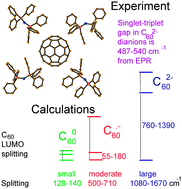Experimental observation of C60 LUMO splitting in the C602− dianions due to the Jahn–Teller effect. Comparison with the C60˙− radical anions†
Abstract
New

* Corresponding authors
a
Institute of Problems of Chemical Physics RAS, Chernogolovka, Moscow region, 142432 Russia
E-mail:
konarev@icp.ac.ru
b
Institute of Solid State Physics RAS, Chernogolovka, Moscow region, 142432 Russia
E-mail:
khasanov@issp.ac.ru
c
Research Institute, Meijo University, 1-501 Shiogamaguchi, Tempaku-ku, Nagoya 468-8502, Japan
E-mail:
gunzi-s@mx2.canvas.ne.jp
New

 Please wait while we load your content...
Something went wrong. Try again?
Please wait while we load your content...
Something went wrong. Try again?
D. V. Konarev, A. V. Kuzmin, S. V. Simonov, E. I. Yudanova, S. S. Khasanov, G. Saito and R. N. Lyubovskaya, Phys. Chem. Chem. Phys., 2013, 15, 9136 DOI: 10.1039/C3CP44359K
To request permission to reproduce material from this article, please go to the Copyright Clearance Center request page.
If you are an author contributing to an RSC publication, you do not need to request permission provided correct acknowledgement is given.
If you are the author of this article, you do not need to request permission to reproduce figures and diagrams provided correct acknowledgement is given. If you want to reproduce the whole article in a third-party publication (excluding your thesis/dissertation for which permission is not required) please go to the Copyright Clearance Center request page.
Read more about how to correctly acknowledge RSC content.
 Fetching data from CrossRef.
Fetching data from CrossRef.
This may take some time to load.
Loading related content
